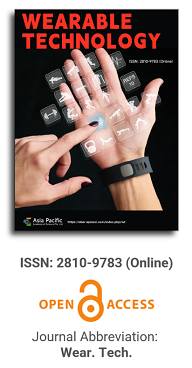

This paper delves deeply into the innovative realm of integrating human emotions with wearable technology. The primary focus is on the conceptualization and development of a kiss transfer device that harnesses the power of wearable technology to bridge the physical gap in human-human interactions. By investigating the intricate nuances of the human-human kissing process, the research seeks to replicate this intimate gesture through a technological medium. The paper not only elaborates on the anatomy, evolution, and hormonal dynamics of kissing but also underscores the transformative potential of wearable technology in capturing and transmitting these intimate moments. This exploration opens up new horizons for long-distance relationships, offering a tangible touchpoint that goes beyond traditional communication methods. Through this pioneering work, the research positions wearable technology as not just a tool for communication but as an extension of our human emotions and expressions.

Study on wearable device users’ willingness to continue using—ECM-IS based on the expansion model
Vol 3, Issue 1, 2022
Download PDF
Abstract
Based on the Expectation Confirmation Model of Information System(ECM-IS), three personal characteristic factors of self-efficacy, privacy concerns, and innovation as well as two external environmental factors of subjective reference and switching costs were introduced to construct a model of factors affecting users’ continuance intention of wearable devices from the perspective of “technology-individual-environment”. 356 valid samples were collected through the questionnaire for empirical analysis. The results of the study show that self-efficacy, switching costs, and perceived usefulness in the ECM-IS model have a significant effect on users’ continuance intention at p<0.001 level while innovativeness and subjective references affect users’ continuance intention at p<0.05, but privacy concerns have no effect on continuance intention.
Keywords
References
- Yang H, Yu J, Zo H, et al. User acceptance of wearable devices: An extended perspective of perceived value. Telematics and Informatics 2016; 33(2): 256–269.
- Gu Z, Xu F, Wei J. An empirical study on the influencing factors of initial trust of wearable business consumers. Management Review 2015; 27(7): 168–176.
- Wu J, Zeng M, Liu F, et al. Research on wearable device user adoption behavior based on meta-analysis method. Journal of Information Resource Management 2017; 7(2): 5–13.
- Bhattacherjee A. Understanding information systems continuance: An expectation-confirmation model. MIS Quarterly 2001; 25(3): 351–370.
- Larsen T, Sreb A, Sreb Y. The role of task-technology fit as user’s motivation to continue information system use. Computers in Human Behavior 2009; 25: 778–784.
- Cho J. The impact of post-adoption beliefs on the continued use of health apps. International Journal of Medical Informatics 2016; 87: 75–83.
- Yin M, Li Q. Research on the willingness of mobile app to continue to use integrating ECT and IS success theory-Taking health app as an example. Journal of Dalian University of Technology (Social Science Edition) 2017; 38(1): 81–87.
- Reddy S, Soror A. Why do you keep doing that? The biasing effects of mental states on it continued usage intentions. Computers in Human Behavior 2017; 33: 209–223.
- Liu Q, Zuo M, Liu M. Empirical analysis on the continuous use of internet applications by the elderly based on expectation confirmation theory. Management Review 2012; 24(5): 89–101.
- Hsu MH, Chiu CM. Predicting electronic service continuance with a decomposed theory of planned behavior. Behavior & Information Technology 2004; 23(5): 359–373.
- Cao Z, Zhao X, Dai Q. Research on influencing factors of customer self-service technology. Nankai Management Review 2010; (3): 90–100.
- Zhou J. User stickiness in the context of social commerce: Indirect influence and regulation of user interaction. Management Review 2015; 27(7): 127–136.
- Dong T, Cheng N, Wu Y, et al. A study of the social net working website service in digital content industries: The Facebook case in Taiwan. Computers in Human Behavior 2014; 30: 708–714.
- Chen H, Li W, Ke Y. Research on sustainable use of social media: Mediated by emotional response. Management Review 2016; 28(9): 61–71.
- Lassar W, Manolis C, Lassar S. The relationship between consumer innovativeness, personal characteristics, and online banking adoption. International Journal of Bank Marketing 2005; 23(2): 176–199.
- Lu J. Are personal innovativeness and social influence critical to continue with mobile commerce? Internet Research 2014; 24(2): 134–159.
- Lin Z, Filieri R. Airline passengers continuance intention towards online check-in services: The role of personal innovativeness and subjective knowledge. Transportation Research Part E: Logistics and Transportation Review 2015; 81: 158–168.
- Lee M. Explaining and predicting user’s continuance intention toward e-learning: An extension of the expectation-confirmation model. Computers & Education 2010; 54(2): 506–516.
- Chen S, Yen D, Hwang M. Factors influencing the continuance intention to the usage of web 2.0: An empirical study. Computers in Human Behavior 2012; 28(3): 933–941.
- Oyeniyi O, Abiodun A. Switching cost and customers loyalty in the mobile phone market: The Nigerian experience. Business Intelligence Journal 2010; 3(1): 111–121.
- Deng A, Tao B, Ma Y. An empirical study on the influencing factors of online shopping customer loyalty. China Management Science 2014; 22(6): 94–102.
- Son J, Kim S. Internet users’ information privacy-protective responses: A taxonomy and a nomological model. Mis Quarterly 2008; 32(3): 503–529.
- Jones M. Mothersbaugh D, Beatty S. Switching barriers and repurchase intentions in services. Journal of Retailing 2000; 76(2): 259–274.
Supporting Agencies
Copyright (c) 2022 Yansheng Zhao, Zhongjie Wang

This work is licensed under a Creative Commons Attribution 4.0 International License.

Prof. Zhen Cao
College of Information Science & Electronic Engineering, Zhejiang University
China, China
Processing Speed
-
-
-
- <5 days from submission to initial review decision;
- 62% acceptance rate
-
-
Asia Pacific Academy of Science Pte. Ltd. (APACSCI) specializes in international journal publishing. APACSCI adopts the open access publishing model and provides an important communication bridge for academic groups whose interest fields include engineering, technology, medicine, computer, mathematics, agriculture and forestry, and environment.





